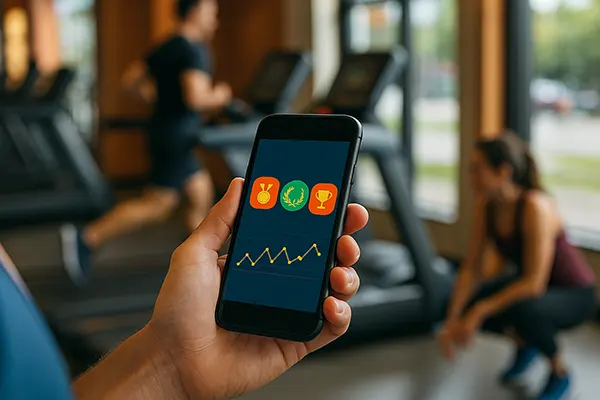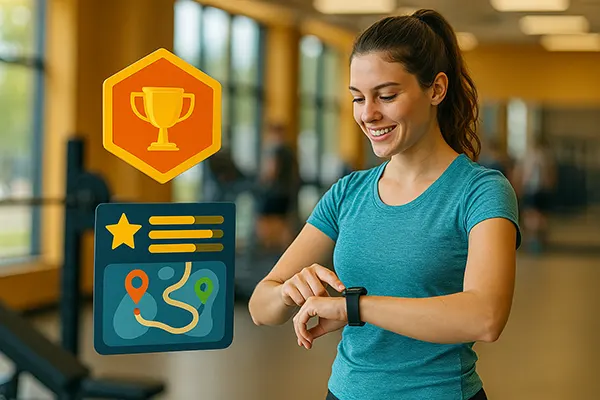
Marketing through Gamification in Fitness Clubs: Badges, Leaderboards, and Challenges
Gamification is rapidly transforming the way fitness clubs engage their members. By turning workouts into games, fitness centres are encouraging loyalty, motivation, and community involvement through strategic use of badges, leaderboards, and challenges. This trend is not just a gimmick; it’s grounded in behavioural science and digital innovation that appeals to a modern, tech-savvy audience.
How Gamification Changes User Behaviour in Fitness Clubs
Fitness clubs across the UK and Europe are increasingly embracing gamification as a way to keep members motivated. Through digital platforms, apps, and smart equipment, clubs offer members the chance to earn points, unlock achievements, and compete with others. These elements turn mundane workouts into dynamic experiences, making users more likely to return and stay consistent in their training.
Many clubs report increased member retention when using gamified systems. When users track their progress through visual indicators like badge collections or progress bars, the satisfaction of progress fuels ongoing participation. The strategy is rooted in behavioural reinforcement: positive feedback loops promote habits, and gamification leverages this principle to keep fitness members engaged long-term.
Importantly, these techniques cater to different personality types. Competitive individuals are drawn to leaderboards and public recognition, while introverted users may prefer personal goals and rewards. A well-designed gamification model can cater to both, ensuring broader appeal and user satisfaction across all demographics.
Examples of Effective Gamification Tools
One of the most commonly used features is the badge system. Whether it’s a “5-Day Streak” or a “Personal Best” award, digital badges give members immediate gratification and a reason to push further. Brands like Myzone and EGYM provide fitness tracking tools that assign visual badges for accomplishments, and these are often shareable on social media, increasing motivation and brand visibility.
Leaderboards are equally impactful. They foster healthy competition and community interaction. Gyms like David Lloyd Clubs and PureGym utilise leaderboard challenges based on calories burned, time spent, or classes attended. These ranking systems refresh weekly or monthly to give new users opportunities to stand out, preventing discouragement and promoting ongoing participation.
Challenges are perhaps the most versatile gamification feature. From daily mobility goals to monthly endurance competitions, challenges allow for creativity and seasonal themes. Many clubs launch themed challenges around holidays or health awareness campaigns, combining fun with education and engagement.
Technological Foundations Powering Gamification
The success of gamification in fitness depends on digital infrastructure. Wearables such as Apple Watch, Fitbit, and Garmin integrate with fitness apps and club software, allowing real-time data tracking. These integrations let users see immediate feedback on their performance, syncing directly with gym systems to automatically reward milestones.
Mobile apps are central to this system. Most major chains now offer club-branded apps with gamification components embedded. These apps not only track workouts but also offer push notifications, achievement alerts, and social interaction tools. Some even include AI-driven recommendations, offering customised challenges based on past performance and goals.
Cloud-based platforms enable clubs to update gamified features regularly without manual intervention. For example, LES MILLS™ Virtual and Technogym’s Mywellness platforms allow gym operators to push new challenges, badges, and leaderboard updates automatically, ensuring the experience remains fresh and stimulating for returning users.
Integrating Gamification with Fitness Equipment
Modern gym equipment has evolved to support gamification natively. Brands such as Life Fitness and Matrix offer cardio machines with built-in screens and interactive interfaces. These allow users to see their progress, compete in virtual races, and unlock achievements without needing separate apps.
Strength training is also part of the gamified ecosystem. Equipment like EGYM Smart Strength automatically adjusts resistance based on user profiles and tracks data across sessions. Users can view charts of their development, earn trophies, and receive weekly progress summaries, all gamified to encourage long-term performance.
This seamless integration reduces friction and makes gamification effortless. Members don’t need to manually log workouts or achievements – it all happens in real-time, increasing the value of each visit and making the fitness experience more immersive and rewarding.

Results, Challenges, and Future Trends
Gamification has shown measurable results in improving gym attendance and customer satisfaction. A 2024 survey by EuropeActive reported that clubs using gamified systems saw 22% higher engagement levels than those that did not. In addition, clubs noticed increased participation in group classes and premium memberships as users were eager to gain access to more reward-earning opportunities.
However, implementation isn’t without challenges. Smaller clubs often struggle with the costs of integrating smart systems or developing branded apps. Data privacy is another concern, especially when collecting personal health data for gamification purposes. Transparency and compliance with GDPR and similar regulations are essential to maintain user trust.
Looking ahead, fitness gamification is likely to evolve through virtual reality (VR), augmented reality (AR), and AI-personalised experiences. Companies like Zwift and Supernatural are already blending immersive tech with physical activity. As adoption becomes more widespread and affordable, the future of gamified fitness promises to be not only engaging but revolutionary.
What Fitness Clubs Should Focus On in 2025
For clubs to maximise the benefits of gamification, user experience must come first. Interfaces should be intuitive, inclusive, and compatible with various fitness levels and preferences. Accessibility features, social integration, and clear instructions are all key to user adoption and long-term engagement.
Data analytics should also play a role in refinement. Clubs that monitor gamification usage patterns can adjust rewards, challenge difficulty, and frequency to maintain motivation. A/B testing different types of badges or challenge durations can help optimise results and increase overall participation.
Finally, partnership opportunities with health insurance providers or wellness platforms may increase. Offering rewards not just within the gym, but also through external benefits like discounts or points schemes, can enhance the value proposition and align fitness with broader lifestyle goals.
Last posts
-
 Marketing Strategies for Women’s Spo...
Marketing Strategies for Women’s Spo...
Women’s sport has entered a new phase of …
-
 Comprehensive Approach to Creating a Right...
Comprehensive Approach to Creating a Right...
In the dynamic landscape of modern sports marketing, …
-
 Green Marketing in Sports: How Clubs and B...
Green Marketing in Sports: How Clubs and B...
In 2025, sustainability has become an inseparable part …
